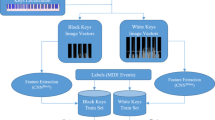Abstract
Nowadays, the development of electronic technology is changing every day. Computer technology has been widely used in various fields; therefore piano tuning teaching needs to keep pace with the social pace, and the tuning industry needs to be updated and explored to make it step on a new stage. In this study, the Fast Fourier Transform, Auto-correlation and Cepstrum feature extraction algorithms for audio visualization software were used to extract and visualize the audio features of seven piano tones from G4 to A4, and according to the characteristics the frequency was calculated and contrasted with the standard audio. Through the sound visualization analysis, it was found that the Auto-correlation algorithm was more consistent with the standard frequency. The use of sound visual tuning detection can plays an auxiliary role in piano tuning teaching.






Similar content being viewed by others
References
Alku, P., Saeidi, R., Alku, P., et al. (2017). The linear predictive modeling of speech from higher-lag autocorrelation coefficients applied to noise-robust speaker recognition. IEEE/ACM Transactions on Audio Speech & Language Processing, 25(8), 1606–1617.
Carpenter, D. J., & Tutwiler, R. L. (2008). Optimization of piano tunings by minimizing perceived beat loudness. Journal of the Acoustical Society of America, 124(4), 2448.
Chouvatut, V., & Jindaluang, W. (2014) Virtual piano with real-time interaction using automatic marker detection. In Computer Science and Engineering Conference. (pp. 222–226). IEEE
Cogliati, A., Duan, Z., & Wohlberg, B. (2016). Transcribing piano music in the time domain. Acoustical Society of America Journal, 140(4), 3038–3038.
Farahani, G. (2017). Autocorrelation-based noise subtraction method with smoothing, overestimation, energy, and cepstral mean and variance normalization for noisy speech recognition. Eurasip Journal on Audio Speech & Music Processing, 2017(1), 13.
Kraft, S., & Zölzer, U. (2015) Polyphonic Pitch Detection by Iterative Analysis of the Autocorrelation Function. In International Conference on Digital Audio Effects. (pp. 211–232).
Mattingly (2012). The effect of singing on the intonation of middle school flute players. Dissertations & Theses—Gradworks, 24(1):109–119.
Muhaimin, H., Danudirdjo, D., Suksmono, A. B., et al. (2015) An efficient audio watermark by autocorrelation methods. In International Conference on Electrical Engineering and Informatics. (pp. 606–611).
Parncutt, R. (1994). Applying psychoacoustics in composition: Harmonic progressions of non-harmonic sonorities. Perspectives of New Music, 32(2), 88–129.
Politis, D., Piskas, G., Tsaligopoulos, M., et al. (2015a) variPiano™: A parametric design variable piano visualizing a differential tuning mobile interface. In International Conference on Interactive Mobile Communication Technologies and Learning. pp. 70–74. IEEE.
Politis, D., Piskas, G., Tsaligopoulos, M., et al. (2015b). variPiano™: Visualizing musical diversity with a differential tuning mobile interface. International Journal of Interactive Mobile Technologies, 9(3), 58.
Saeidi, R., Alku, P., & Backstrom, T. (2016) Feature extraction using power-law adjusted linear prediction with application to speaker recognition under severe vocal effort mismatch. IEEE/ACM Transactions on Audio Speech & Language Processing, 24(1):42–53.
Spierer, A., & Upegui, A. Real-time audio group delay correction with FFT convolution on FPGA. Applied Reconfigurable Computing. Springer International Publishing, 2016:233–244.
Wang, Q., Zhou, R., & Yan, Y. (2018). Polyphonic Piano Transcription with a Note-Based Music Language Model. Applied Sciences, 8(3), 470.
Author information
Authors and Affiliations
Corresponding author
Additional information
Publisher’s Note
Springer Nature remains neutral with regard to jurisdictional claims in published maps and institutional affiliations.
Rights and permissions
About this article
Cite this article
Zhang, D. Application of audio visual tuning detection software in piano tuning teaching. Int J Speech Technol 22, 251–257 (2019). https://doi.org/10.1007/s10772-019-09599-5
Received:
Accepted:
Published:
Issue Date:
DOI: https://doi.org/10.1007/s10772-019-09599-5




